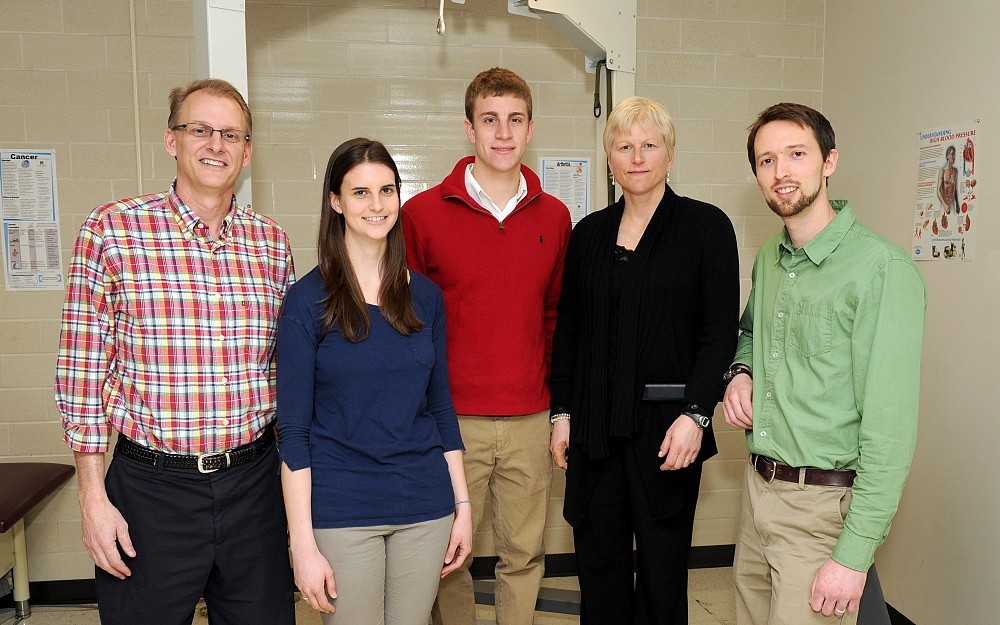
Team Studies Interval Training to Improve Fitness and Function In Stroke Survivors
CINCINNATIHigh-intensity interval training has been shown to help both high-performing athletes and cardiac patientsbut could it help stroke survivors regain their fitness and improve their motor functioning?
Thats what a team of University of Cincinnati (UC) researchers hope to discover in a new study, funded with a grant from the Foundation for Physical Therapy and an award from UCs Provosts Pilot Research Program.
Kari Dunning, PhD, an assistant professor of rehabilitation sciences at UCs College of Allied Health Sciences, and Brett Kissela, MD, professor of neurology and rehabilitation medicine at UCs College of Medicine, are leading the study "High Intensity Interval Training in Chronic Stroke, as co-principal investigators.
Dunning, Kissela and their colleagues aim to develop new high-intensity training protocols for stroke rehabilitation and to test the protocols effectiveness in rebuilding patients cardiovascular and motor functioning.
"Often after a stroke, survivors lose their cardiovascular conditioning, which contributes to decreasing motor function, says Dunning, "Our hope is that, by increasing their cardiovascular fitness with high intensity training on a treadmill, we can increase their motor function as well.
High-intensity interval training, an exercise strategy alternating short periods of intense exercise with longer recovery periods, has been shown to improve cardiovascular conditioning in a variety of populations.
But Dunning says current clinical rehabilitation care isnt set up to provide such training. This means that stroke survivors often never have an opportunity to get back into shape, contributing to a long-term decrease in function.
It can also lead to a drop in physical activity. Statistically, stroke survivors walk less than their peers, taking less than 1,500 to 2,000 steps a day, compared with about 7,000 steps a day for the average older adult.
"We know that 45 minutes of exercise, three times a week improves patients cardiovascular condition, but thats not feasible in the clinical setting, says Dunning. "By using high-intensity interval training, patients can work out for 20-25 minutes and get the same benefitsand the physical therapist can use the rest of their session to work on other motor tasks.
Co-investigators on the project also include assistant professor of rehabilitation sciences Dan Carl, PhD, and visiting instructor Pierce Boyne, DPT, both in the College of Allied Health Sciences.
Boyne, DPT says this kind of intensive task practice has direct benefit on motor function for people with stroke, by promoting neural rewiring in the brain.
"Accumulating evidence suggests that exercise intensity is a critical ingredient for driving the brain to rewire after injury, he says. "We are optimistic that the high-intensity interval training protocol that we develop will also have a direct impact on motor function for people with stroke.
The researchers will first work on developing an interval training protocol that balances safety with the intensity necessary to drive both cardiovascular fitness and changes in the brain. With an optimized protocol, they will work with patients for four weeks, implementing the protocols three times a week and measuring improvements in cardiovascular fitness and gait.
Clinicians are typically hesitant to do intense exercise with persons with stroke. To assure safety, the interdisciplinary team includes a cardiologist, Myron Gearson, MD, professor of cardiology and radiology and director of the UC Medical Center Cardiac Stress Laboratory. Also collaborating with the team is Jane Khoury, PhD, associate professor of biostatistics and epidemiology at the Cincinnati Childrens Hospital Medical Center.
While this study focuses on chronic stroke patients, or patients who are six months or more post-stroke, Dunning says the protocol could eventually help patients in the early recovery stages.
"The ideal health care scenario is to start training during their in-patient rehabilitation so patients are not as deconditioned later in recovery, she says. "Ultimately, we want to develop a training protocol that not only fits in the current clinical model for physical therapy, but gives patients a boost on their conditioning and the ability to work out in the community on their own.
Related Stories
Can new rules in Ohio address a pharmacy staffing shortage and...
May 17, 2024
The University of Cincinnati's Michael Hegener joined WVXU's Cincinnati Edition to discuss recent rules released by the Ohio Board of Pharmacy designed to address pharmacy staffing.
Is ketamine the answer to treatment-resistant depression?
May 16, 2024
The University of Cincinnati's Stephen Rush joined WVXU's Cincinnati Edition to discuss the use of ketamine and esketamine to treat treatment-resistant depression.
UC study: Severe ischemic strokes rare in total patient...
May 15, 2024
The University of Cincinnati’s Yasmin Aziz will present research at the European Stroke Organisation Conference that found severe ischemic strokes with the most severe damage are rare in the total stroke patient population.
